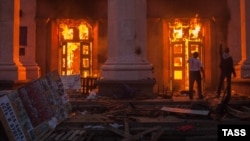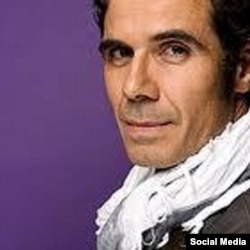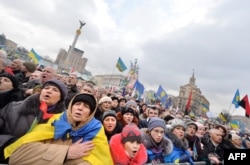The film Ukraine: The Masks Of The Revolution tells the “real” story of the Euromaidan protests. At least that’s what filmmaker Paul Moreira claims.
In a nutshell, according to Moreira, it was right-wing extremists who ousted Viktor Yanukovych during the 2013-14 Euromaidan demonstrations, not the tens of thousands of ordinary and peaceful Ukrainians who took to the streets day after day.
The West is complicit as well, turning a blind eye to the extremists’ crimes, including deadly violence in the southern city of Odesa in May 2014.
Why? Because Ukraine was merely a "pawn" -- albeit a crucial one -- in the greater geopolitical tug-of-war between the Kremlin and the West.
If that sounds familiar, it should. It’s essentially the narrative that the Kremlin and its followers have been spinning -- that is, blood-lusting neo-Nazi Ukrainians preying on unsuspecting Russian-speakers and other vulnerable minorities.
On its Facebook page, the Ukrainian Embassy in France said the film, which is set to air on the French Canal Plus television channel on February 1, is “not only dishonest, but completely disrespectful to our compatriots murdered in the heart of Kyiv while defending the democratic aspirations of their country.”
The embassy did not demand Canal Plus pull the film, as has been reported by RT, but says the channel “would be well-advised to reconsider the dissemination of the film.”
In an opinion piece on January 29 in The Kyiv Post, Halya Coynash, a member of the Kharkiv Human Rights Protection Group, pans the film as bad propaganda, filled with “manipulative reporting and outright lies.”
Coynash takes exception to Moreira’s claim that the West whitewashed the role of extreme right-wing activists during the Euromaidan protests.
“There have been numerous reports, both in Ukraine and abroad, about the role of the ultranationalist Right Sector and far-right VO Svoboda party during Euromaidan," he wrote. "There has also been considerable coverage of the Azov Battalion and other volunteer battalions fighting against Kremlin-backed militants and Russia in Donbas, with many reports focusing on the ideology espoused by at least the battalion leaders.”
The film also focuses on the murky events of May 2, 2014, when 48 pro-Russia protesters were killed and several hundred injured in a fire at a Soviet-era Trade Unions building in Odesa during a showdown with pro-Ukraine activists.
But for filmmaker Moreira, there’s nothing unclear about what happened. Far-right paramilitaries “slaughtered with full impunity," much like the pro-Kremlin crowd has claimed, although reality may tell a different story.
On May 2, 2014, clashes broke out in Odesa between what were said to be pro-Russian supporters of greater federalism in Ukraine and pro-union rivals.
As the fighting turned deadly and police failed to restore order, the pro-federalism protesters retreated into the Trade Union Building, where they were surrounded by pro-unionists. The two sides exchanged shots and hurled Molotov cocktails through the windows at each other, with each subsequently blaming the other for the fires that broke out in the building.
A report by the Council of the Europe, while faulting Kyiv for incompetently investigating the tragedy, did note that official forensic examinations suggested the fires started in five places and that "other than the fire in the lobby, the fires could only have been started by those inside the building."
The panel also took note of a report by a local nongovernmental organization, the 2 May Group, which said the fire spread to the building after a barricade in front of the entrance was set ablaze as a result of the exchange of Molotov cocktails.
Seemingly left out of Moreira’s film are the average Ukrainians who put their lives on hold to take part in protests sparked by Yanukovych’s abrupt volte-face on relations with Europe, opting instead to stay inside Moscow's orbit.
Those voices, however, are heard in another film examining events in Ukraine during those fateful days.
Winter On Fire turns the cameras on the enthusiastic activists, wizened soldiers, distressed medics, local pop stars, and even a young Romany boy, who all spent months in atrocious weather facing down police bullets and batons as they fought for sweeping reform and a more Westward orientation.
The film, by director Evgeny Afineevsky, was nominated for an Academy Award for best documentary feature on January 14.










